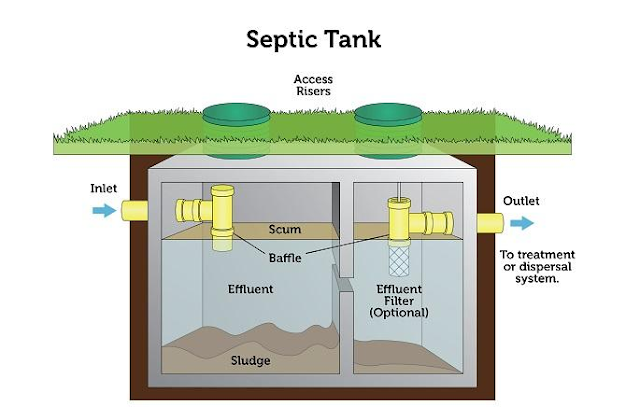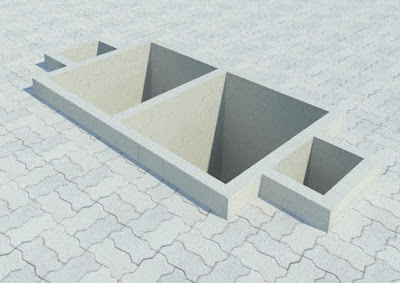Over the past few weeks, I realized a lot of people really would love to know what the parts of a septic system are! Because of this, i have decided to create one of the most comprehensible contents on the subject matter. Perhaps, knowing this would help you understand why it is very important to always ensure the services of a professional is highly required whenever septic systems are designed!
Before anything on parts of a septic system, it could be remembered that guardian constructors have in several previous posts, explained what a septic tank is as well as how septic tanks work. But for the sake of our new readers, we shall leave a quick explanation to some of the important aspects of the subject matter
What is a Septic System?
A septic system could be described as a network of processes that enhance the efficient collection, storage, and treatment as well as discharge of treated wastewater without causing a nuisance to the immediate environment.
Efficiency in septic systems means there are no foul smells, leakages, or improper discharge of treated or untreated wastewater to the environment.
Most septic systems comprise of the septic tank, the piping network, soil, and finally the leach field
Now that we have described a septic system, lets us see the major parts of a septic system.
Recommended
Parts of a Septic system
In most cases, there are 4 major parts of a septic system and these we shall discuss below with accompanying diagrams!
1. Piping Network
2. Septic tank
3. Drain field and
4. The Soil
The Piping Network as one of the major Parts of a Septic System
The Pipe as one of the parts of a septic system ensures wastewater is collected from the home (Kitchen, bathrooms) to the septic tank which is buried just outside the home. However, the pipe also conveys treated waster water from the septic tank off to the drain field where these are discharged to the environment.
The pipe is therefore the starting point of a septic system and also ends it since the drain field comprises of perforated pipes who discharges treated wastewater to the surroundings!
The Septic Tank As one of the major Parts of a septic system
 |
Figure 2: Septic Tank
Source: Epa.gov |
The Septic Tank as one of the parts of a septic system first receives the wastewater as ushered in by the pipes. As these wastes collate, they are gradually segmented into the scum, effluent, and sludge.
While the sludge which comprises of oil and grease floats at the very top of the septic tank, the effluent on the other hand is the middle section which is water.
The scum (First layer) and the Effluent (second layer) are, however, prevented from leaving the septic tank by a specially designed T-shaped pipe which serves as the outlet.
Also within the septic tank is the Sludge layer which i would say is the total collection of all solids that are denser than water, thus unable to float or flow. They are retained at the bottom of the septic tank and remain here till they are pumped out. Thus, when you begin to notice the septic has started to develop some smell or show signs of malfunction, then it might be due for pumping.
Parts Of a Septic Tank
The septic Tank as described above is a wastewater treatment chamber. There are many parts of a septic tank. These parts of a septic tank Include:
- Inlet and outlet pipes
- compartments
- Filter
- Inspection Pipe and
- Manhole Cover.
- Inlet Pipe ushers wastewater emanating from the home into the septic tank, the Compartment contains these wastewater and serves as the treatment center cos this is where the waste collated is separated into the Scum, effluent and sludge
- The Filter is often attached to the Outlet pipe. It prevents to escape of solids to the drain field as well as connects treated wastewater to the drain field where they are finally discharged to the surrounding soil to receive further action by bacteria in the soil
- The inspection Pipe is that part of a septic tank that is used to check when the septic tank is filled or due for septic pumping. We can simple describe the inspection pipe as the screen.
- Manhole cover is the part of a septic tank which helps cover the tank in order to prevent the escape of water from the top opening of the septic tank. It also serves as the entry point especially when the septic inspect officers come around to determine whether or not a pumping service is required. The manhole also helps a lot during Septic tank Repairs
- The Outlet Pipe is the part of a septic tank that sends treated water or effluent off to the drain field. The Outlet pipe in most cases is in direct connection with the Filter
Drain field One of the Major Parts of a septic system
Call it a drain field or leach field, this is one of the major parts of a septic system that does the secondary work. Depending on the number of occupants, after a few months of designing your septic system, the drain field starts to function. It receives treated water and through perforated pipes, these are discharged to the earth where microbes and bacteria are surely going to act and use these to enrich the soil…
The soil As one of the major parts of the septic system
The soil is another of the many important parts of a septic system in that it is the point of exit for all treated wastewater coming from the septic system.
The soil is the platform on which the drain field is constructed. Based on this, it is important that the drain field piping network be submerged in the right soil.
Having the drain field designed on a soil with low pore spaces is one risk no plumber or septic professional would ever want to make as this could lead to clogging of the septic system.
A Clogged septic system only means the system has failed to achieve the primary secondary objectives of the entire system – Efficient Discharge of treated wastewater to the drain or leach
What is the best soil for septic drain field construction?
This is one aspect of septic system construction that musty never be taken for granted because a number of recent studies have shown that the type of soil used often affects the level effectiveness of a septic system.
It is important to pay a more than usual attention to the major properties of soil (Structure, Drainage, and Texture)
Soil Structure
When we consider soil structure, it is required that soils used for septic systems have large pore spaces between the grains and these spaces must be highly interconnected in order to make it for natural processes such as Drying, wetting, and Thawing to take place.
Soil Texture
Aside from having large pore spaces, soils used for septic drain field design are not required to have too much clay or silt present.
This is because too much clay makes the soil too heavy while soils having too much silt really have fewer pores to allow drainage of soil water.
Soil Drainage
When soil drainage is poor, it would be somewhat difficult for treated wastewater to percolate
Soil Moisture levels
Popularly referred to as soil drainage, is the ability for water to naturally drain water from the area. It is therefore required that Soil moisture content tests be carried out to determine is resident or alien materials would be used for the construction of a septic system.
Recommended
From the above therefore, it is possible to say the most suitable type of soil for drain field design includes:
Soils with low clay content
Sandy soil (level of sandiness must supersede all other characteristics)
Soils with Non-Retentive or Non-Absorbing ability
Grounds with low clay content
Conclusion
In conclusion, There are 4 major parts of a septic system without which the system cannot function properly. However, it is very important that a few of these parts also has other parts that enables them function properly.
For instance, the Septic tank is that major parts of the septic system that may not function properly without the Filter and pipe networks.
Also, the Drain field is a system on its own that requires proper soil analysis and the accuracy from the hands of a professional in order to function effectively.
From the study, we also identified the soil as another important part of a septic system since a soil with little pore spaces may not favor the percolation of wastewater.
We also picked most suitable types of soil for the construction of septic systems and drain field include;
Soils with low clay content
Sandy soil (level of sandiness must supersede all other characteristics), etc
This is it on the parts of a septic system!
I look forward for your comments and criticisms. However, if you find this page good enough, please share with others as they may be looking out for the best and most comprehensible article focusing on parts of a septic system.




